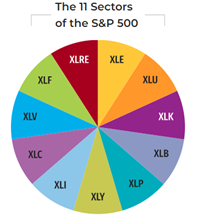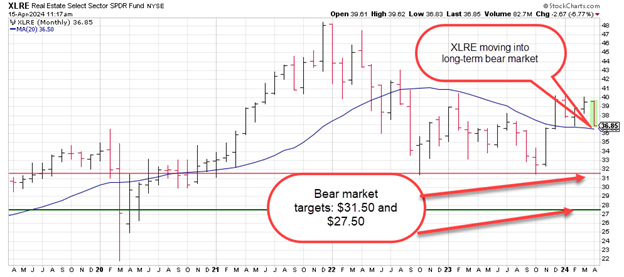For clarification, I’m using the Real Estate Sector SPDR ETF (XLRE) as “the market” here.
Over the last three months, we’ve heard a lot of comments on the real estate market from Jamie Dimon.
- The U.S. real estate market can avoid a crisis
- The real estate market will muddle through the current economic situation
- Stagflation would be a real estate market killer. Sidenote, stagflation would be the worst case for everything
You get the idea. We’ve been handed warnings from Mr. Dimon, while other analysts and CEOs are telling investors that the real estate market is fine.
This is where I fall back on the one and only truth on Wall Street… Prices.
Namely the price activity in the real estate sector by way of the XLRE.
The XLRE is one of the eleven sectors that make up the S&P 500.
The weighting of the ETF covers a broad swath of the real estate market focusing on commercial real estate companies like Prologis (PLD) (a logistics company), Equinix (EQIX) (a data center company), and American Tower Corporation (AMT) (a wireless infrastructure company).
After some very strong confidence in the sector, investors are paring back on their holdings. At least that’s what the price chart tells you.
Shares of the XLRE are 8% from their one-year highs and 25% from their all-time highs.
The shares are preparing to cross two price trends that have negative implications. Those breaks would target another 12-15% decline in the real estate ETF over the next three to four months.
At the core of the selling is the interest rate situation. XLRE shares dropped in 2022 as inflation forced analysts and investors to look at a wall of debt in the real estate market that will have to be refinanced in 2024.
According to the Mortgage Bankers Association, more than $900 billion in commercial real estate loans will have to be refinanced in 2024. The Fed’s “higher for longer” outlook is changing the way the market looks at the risks of those refinancing activities.
That fundamental is pushing the XLRE to their 200-day moving average. That’s the first line in the sand.
Shares are less than 1% above this critical trendline as they trade at the round numbered $37. That $37 price was also a bottom for the ETF in February, the same time that we started to realize the Fed may hold rates higher through 2024.
A breakthrough that line will increase the number of sellers in the market, forcing the XLRE to their next critical line… the 20-month moving average.
This long-term trendline is considered the technical analysis line of demarcation between a bull and bear market. The 20-month sits at $36.50.
That means you can break through two critical technical trends with less than a 2% decline in the XLRE.
The last break of the 20-month moving average took the XLRE shares to a price of $31.50, which you should now consider the best-case scenario for the ETF.
The worst-case scenario for the real estate ETF would include the Fed indicating that an interest rate hike was on the table due to inflation risks.
That move alone would likely target a price of $27.50 for the XLRE shares, a 25% decline from today’s prices.
What’s an Investor to Do?
If you’re long the Real Estate ETF, consider a plan to limit losses. This is not about the XLRE going to $0, it’s about being able to avoid intermediate- to long-term losses with the opportunity to buy the same ETF back at 10-15% lower prices than now.
Remember, avoiding a large loss and buying something back at lower prices is how wealth is generated in the market.
As always, aggressive investors may consider long-term put options on the XLRE.
About the Author
Chris Johnson (“CJ”), a seasoned equity and options analyst with nearly 30 years of experience, is celebrated for his quantitative expertise in quantifying investors’ sentiment to navigate Wall Street with a deeply rooted technical and contrarian trading style.




